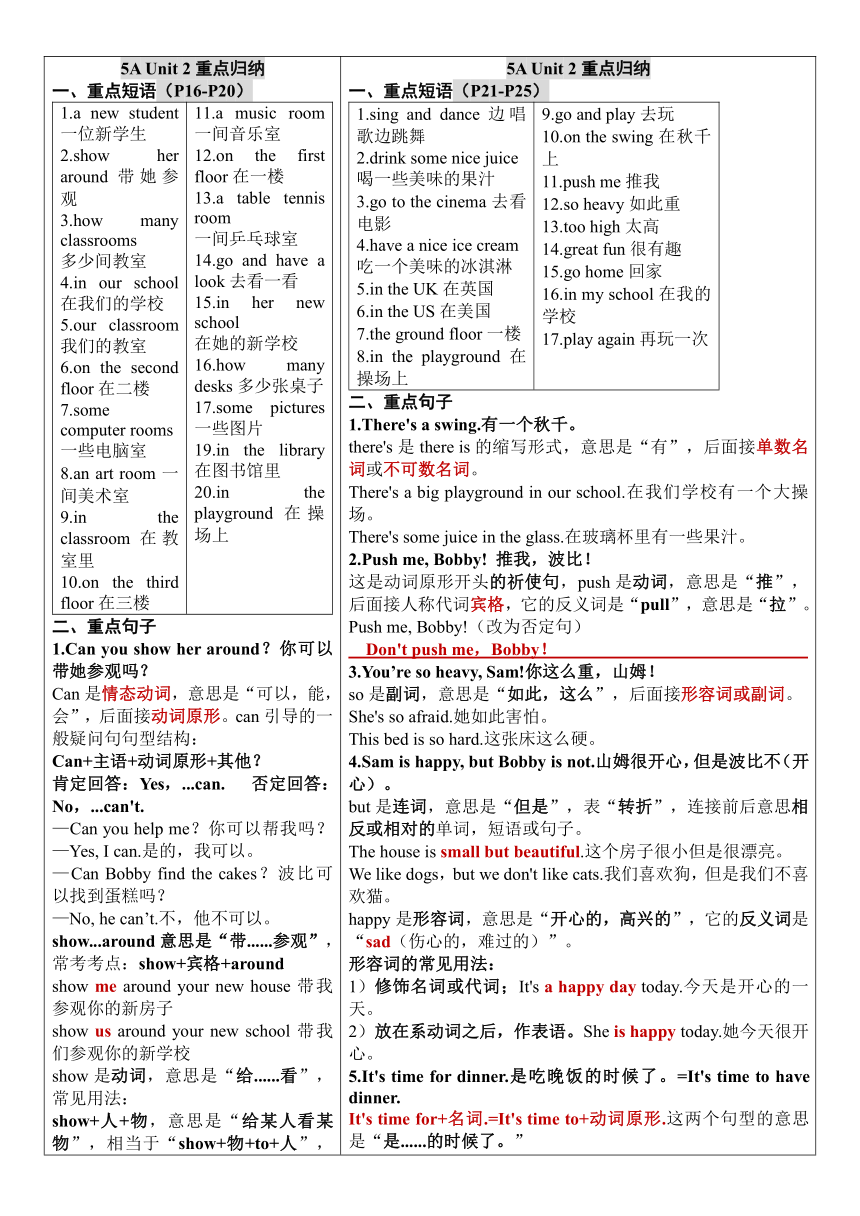Unit 2 A new student 重点知识归纳知识清单
文档属性
| 名称 | Unit 2 A new student 重点知识归纳知识清单 |  | |
| 格式 | docx | ||
| 文件大小 | 24.1KB | ||
| 资源类型 | 教案 | ||
| 版本资源 | 牛津译林版 | ||
| 科目 | 英语 | ||
| 更新时间 | 2024-10-15 08:21:28 | ||
图片预览

文档简介
5A Unit 2重点归纳 一、重点短语(P16-P20) 1.a new student一位新学生 2.show her around带她参观 3.how many classrooms 多少间教室 4.in our school在我们的学校 5.our classroom我们的教室 6.on the second floor在二楼 7.some computer rooms 一些电脑室 8.an art room一间美术室 9.in the classroom在教室里 10.on the third floor在三楼11.a music room一间音乐室 12.on the first floor在一楼 13.a table tennis room 一间乒乓球室 14.go and have a look去看一看 15.in her new school 在她的新学校 16.how many desks多少张桌子 17.some pictures一些图片 19.in the library在图书馆里 20.in the playground在操场上
二、重点句子 1.Can you show her around?你可以带她参观吗? Can是情态动词,意思是“可以,能,会”,后面接动词原形。can引导的一般疑问句句型结构: Can+主语+动词原形+其他? 肯定回答:Yes,...can. 否定回答:No,...can't. —Can you help me?你可以帮我吗? —Yes, I can.是的,我可以。 —Can Bobby find the cakes?波比可以找到蛋糕吗? —No, he can’t.不,他不可以。 show...around意思是“带......参观”,常考考点:show+宾格+around show me around your new house带我参观你的新房子 show us around your new school带我们参观你的新学校 show是动词,意思是“给......看”,常见用法: show+人+物,意思是“给某人看某物”,相当于“show+物+to+人”,意思是“把某物给某人看”。 Can you show me your computer?你可以给我看看你的电脑吗? =Can you show your computer to me? 2.How many classrooms are there in our school? 在我们学校有多少间教室? “How many+复数名词+are there+地点?”是对There be句型中的可数名词的“数量”提问。 对划线部分提问: There are 24 computers in the room. How many computers are there in the room? There is a bed in the bedroom. How many beds are there in the bedroom? 3.Our classroom is on the second floor.我们的教室在二楼。 second是“序数词”,表示顺序或名次。序数词的常见用法是: ①the+序数词+单数名词 ②形容词性物主代词/名词所有格+序数词+单数名词 two是“基数词”,表示数字或数量。基数词(>1)+复数名词 There are five floors in the house. 这个房子有五层。 My bedroom is on the third floor.我的卧室在三楼。 This is my second computer.这是我的第二台电脑。 4.—Are there any computer rooms?有一些电脑室吗? —Yes, there are.是的,有。 —Is there a music room?有一间音乐室吗? —Yes, there is.是的,有。 【There be句型一般疑问句】 Are there any+复数名词+地点? 肯定回答:Yes, there are. 否定回答:No, there aren’t. Is there+a/an+单数名词+地点? Is there any+不可数名词+地点? 肯定回答:Yes, there is. 否定回答:No, there isn't. 5.Let's go and have a look.咱们去看一看吧。 这是一个用来提建议的祈使句,let's=let us,意思是“咱们”,后面接动词原形;let是动词,意思是“让”,us是人称代词宾格,意思是“我们”,let+宾格+动词原形。 Let's go and play.咱们去玩吧。Let's go home now.现在咱们回家吧。 Let him have a try.让他试一试。 Let her have a rest.让她休息吧。 5A Unit 2重点归纳 一、重点短语(P21-P25) 1.sing and dance边唱歌边跳舞 2.drink some nice juice 喝一些美味的果汁 3.go to the cinema去看电影 4.have a nice ice cream 吃一个美味的冰淇淋 5.in the UK在英国 6.in the US在美国 7.the ground floor一楼 8.in the playground在操场上9.go and play去玩 10.on the swing在秋千上 11.push me推我 12.so heavy如此重 13.too high太高 14.great fun很有趣 15.go home回家 16.in my school在我的学校 17.play again再玩一次
重点句子 1.There's a swing.有一个秋千。 there's是there is的缩写形式,意思是“有”,后面接单数名词或不可数名词。 There's a big playground in our school.在我们学校有一个大操场。 There's some juice in the glass.在玻璃杯里有一些果汁。 2.Push me, Bobby! 推我,波比! 这是动词原形开头的祈使句,push是动词,意思是“推”,后面接人称代词宾格,它的反义词是“pull”,意思是“拉”。 Push me, Bobby!(改为否定句) Don't push me,Bobby! 3.You’re so heavy, Sam!你这么重,山姆! so是副词,意思是“如此,这么”,后面接形容词或副词。 She's so afraid.她如此害怕。 This bed is so hard.这张床这么硬。 4.Sam is happy, but Bobby is not.山姆很开心,但是波比不(开心)。 but是连词,意思是“但是”,表“转折”,连接前后意思相反或相对的单词,短语或句子。 The house is small but beautiful.这个房子很小但是很漂亮。 We like dogs,but we don't like cats.我们喜欢狗,但是我们不喜欢猫。 happy是形容词,意思是“开心的,高兴的”,它的反义词是“sad(伤心的,难过的)”。 形容词的常见用法: 修饰名词或代词;It's a happy day today.今天是开心的一天。 2)放在系动词之后,作表语。She is happy today.她今天很开心。 5.It's time for dinner.是吃晚饭的时候了。=It's time to have dinner. It's time for+名词.=It's time to+动词原形.这两个句型的意思是“是......的时候了。” It's time for lunch.=It's time to have lunch.是吃午饭的时候了。 It's time for bed.=It’s time to sleep.=It's time to sleep.该睡觉了。 6.人称代词和物主代词 主格Iweyouhesheitthey宾格meusyouhimheritthem形物myouryourhisheritstheir
主格,放在谓语动词之前,作主语;He is a student.他是一名学生。 宾格,放在动词、介词之后,作宾语或表语; Can you show him around?你可以带他参观吗? Mike has lunch with him.迈克和他一起吃午饭 形容词性物主代词,后面接名词。 Mike is his brother.迈克是他的弟弟。 【语音部分】 C /k/cold/doctor/cousin/come/coat/cup/cake/country/cat/car/can /second/clean/cool/music/computer/picture/CanadaC /s/Alice/dance/nice/juice/cinema/ice/face/city/science/pencil /rice
【文化部分】 在英国(the UK),“一楼”是“the ground floor”,“二楼”是“the first floor”,“三楼”是“the second floor”。 在美国(the US),“一楼”是“the first floor”,“二楼”是“the second floor”,“三楼”是“the third floor”。
二、重点句子 1.Can you show her around?你可以带她参观吗? Can是情态动词,意思是“可以,能,会”,后面接动词原形。can引导的一般疑问句句型结构: Can+主语+动词原形+其他? 肯定回答:Yes,...can. 否定回答:No,...can't. —Can you help me?你可以帮我吗? —Yes, I can.是的,我可以。 —Can Bobby find the cakes?波比可以找到蛋糕吗? —No, he can’t.不,他不可以。 show...around意思是“带......参观”,常考考点:show+宾格+around show me around your new house带我参观你的新房子 show us around your new school带我们参观你的新学校 show是动词,意思是“给......看”,常见用法: show+人+物,意思是“给某人看某物”,相当于“show+物+to+人”,意思是“把某物给某人看”。 Can you show me your computer?你可以给我看看你的电脑吗? =Can you show your computer to me? 2.How many classrooms are there in our school? 在我们学校有多少间教室? “How many+复数名词+are there+地点?”是对There be句型中的可数名词的“数量”提问。 对划线部分提问: There are 24 computers in the room. How many computers are there in the room? There is a bed in the bedroom. How many beds are there in the bedroom? 3.Our classroom is on the second floor.我们的教室在二楼。 second是“序数词”,表示顺序或名次。序数词的常见用法是: ①the+序数词+单数名词 ②形容词性物主代词/名词所有格+序数词+单数名词 two是“基数词”,表示数字或数量。基数词(>1)+复数名词 There are five floors in the house. 这个房子有五层。 My bedroom is on the third floor.我的卧室在三楼。 This is my second computer.这是我的第二台电脑。 4.—Are there any computer rooms?有一些电脑室吗? —Yes, there are.是的,有。 —Is there a music room?有一间音乐室吗? —Yes, there is.是的,有。 【There be句型一般疑问句】 Are there any+复数名词+地点? 肯定回答:Yes, there are. 否定回答:No, there aren’t. Is there+a/an+单数名词+地点? Is there any+不可数名词+地点? 肯定回答:Yes, there is. 否定回答:No, there isn't. 5.Let's go and have a look.咱们去看一看吧。 这是一个用来提建议的祈使句,let's=let us,意思是“咱们”,后面接动词原形;let是动词,意思是“让”,us是人称代词宾格,意思是“我们”,let+宾格+动词原形。 Let's go and play.咱们去玩吧。Let's go home now.现在咱们回家吧。 Let him have a try.让他试一试。 Let her have a rest.让她休息吧。 5A Unit 2重点归纳 一、重点短语(P21-P25) 1.sing and dance边唱歌边跳舞 2.drink some nice juice 喝一些美味的果汁 3.go to the cinema去看电影 4.have a nice ice cream 吃一个美味的冰淇淋 5.in the UK在英国 6.in the US在美国 7.the ground floor一楼 8.in the playground在操场上9.go and play去玩 10.on the swing在秋千上 11.push me推我 12.so heavy如此重 13.too high太高 14.great fun很有趣 15.go home回家 16.in my school在我的学校 17.play again再玩一次
重点句子 1.There's a swing.有一个秋千。 there's是there is的缩写形式,意思是“有”,后面接单数名词或不可数名词。 There's a big playground in our school.在我们学校有一个大操场。 There's some juice in the glass.在玻璃杯里有一些果汁。 2.Push me, Bobby! 推我,波比! 这是动词原形开头的祈使句,push是动词,意思是“推”,后面接人称代词宾格,它的反义词是“pull”,意思是“拉”。 Push me, Bobby!(改为否定句) Don't push me,Bobby! 3.You’re so heavy, Sam!你这么重,山姆! so是副词,意思是“如此,这么”,后面接形容词或副词。 She's so afraid.她如此害怕。 This bed is so hard.这张床这么硬。 4.Sam is happy, but Bobby is not.山姆很开心,但是波比不(开心)。 but是连词,意思是“但是”,表“转折”,连接前后意思相反或相对的单词,短语或句子。 The house is small but beautiful.这个房子很小但是很漂亮。 We like dogs,but we don't like cats.我们喜欢狗,但是我们不喜欢猫。 happy是形容词,意思是“开心的,高兴的”,它的反义词是“sad(伤心的,难过的)”。 形容词的常见用法: 修饰名词或代词;It's a happy day today.今天是开心的一天。 2)放在系动词之后,作表语。She is happy today.她今天很开心。 5.It's time for dinner.是吃晚饭的时候了。=It's time to have dinner. It's time for+名词.=It's time to+动词原形.这两个句型的意思是“是......的时候了。” It's time for lunch.=It's time to have lunch.是吃午饭的时候了。 It's time for bed.=It’s time to sleep.=It's time to sleep.该睡觉了。 6.人称代词和物主代词 主格Iweyouhesheitthey宾格meusyouhimheritthem形物myouryourhisheritstheir
主格,放在谓语动词之前,作主语;He is a student.他是一名学生。 宾格,放在动词、介词之后,作宾语或表语; Can you show him around?你可以带他参观吗? Mike has lunch with him.迈克和他一起吃午饭 形容词性物主代词,后面接名词。 Mike is his brother.迈克是他的弟弟。 【语音部分】 C /k/cold/doctor/cousin/come/coat/cup/cake/country/cat/car/can /second/clean/cool/music/computer/picture/CanadaC /s/Alice/dance/nice/juice/cinema/ice/face/city/science/pencil /rice
【文化部分】 在英国(the UK),“一楼”是“the ground floor”,“二楼”是“the first floor”,“三楼”是“the second floor”。 在美国(the US),“一楼”是“the first floor”,“二楼”是“the second floor”,“三楼”是“the third floor”。
